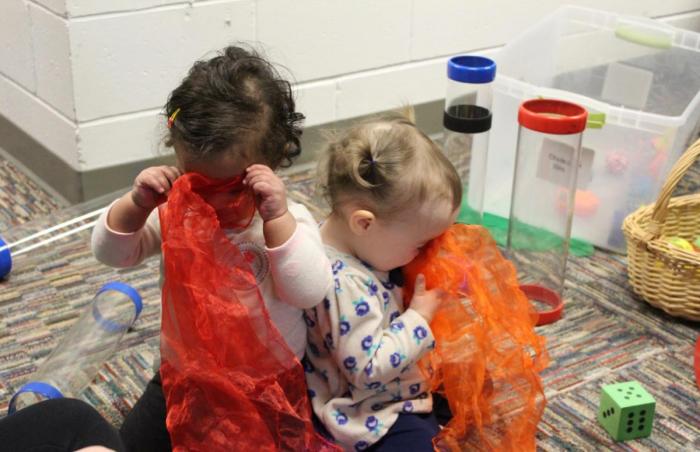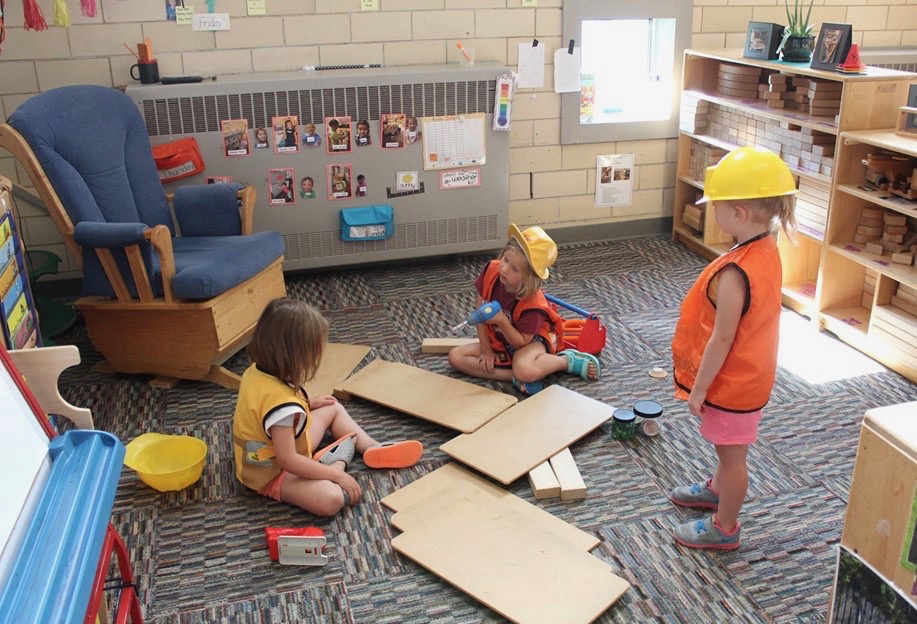Classrooms
Individualized attention and age-appropriate activities to meet every child's needs
At the CDC, we work to ensure a climate of mutual respect. We recognize the uniqueness of each child and provide a developmentally appropriate, child-directed learning environment. Our teachers guide hands-on exploration which supports social-emotional, physical and cognitive development. We welcome the involvement of parents and family members in the program.
Five classrooms caring for infants to five-year-olds operate during the academic school year:
- Kittens
- Cubs
- Cats
- Pumas
- Panthers
Ten full-time teachers certified in early childhood education and student staff members lead these classrooms. During the summer months, we tend to decrease in numbers and have three sessions in May, June and July.
We also provide breakfast, lunch and snacks as a part of our service per the USDA Child and Adult Care Food Program.
The Classroom Experience and Environment
Each classroom provides a safe, nurturing and stimulating environment for children to explore throughout their day. Experiences with teachers, peers, language, movement, music, books, sensory, art and dramatic play materials enhance children’s growth and development. All experiences align with Iowa Early Learning Standards along with Teaching Strategies GOLD, which is an assessment tool.

Feeding and mealtimes
Eating is both a physical and social-emotional process. From holding your infants when bottle feeding or encouraging self-help among our older children, we use this time to nurture, engage and encourage growing independence. Our older children use this time to try new foods, use developing language skills, engage in social interactions and practice self-help skills.
Exploring
In each classroom, teachers design the environment and experiences based on children’s developmental needs and individual interests. We encourage your child to be as independent as possible. That includes getting messy or going outside, weather permitting. Please dress your children with this in mind and provide appropriate outerwear and walking shoes for each season.
Each classroom uses the University of Northern Iowa's campus as a tool for learning. Trips to campus include: visiting the library, greenhouse, book store and exploring many of the buildings on campus–whether walking or via stroller!
Sleeping
Sleeping or napping is an important time of the day for all. Infants sleep in cribs and then transition to cots at age 1, while older children sleep on cots. Your older child may be more comfortable with a small blanket, pillow or sleeping toy brought from home. Teachers help children relax by reading stories, playing soft music, or rubbing backs. While some older children may not nap, all children must spend some time resting every day.
Sharing your child’s experiences
We look forward to developing relationships with children and their families. Your child’s teachers document their experiences daily, often using photographs, dictation, and artwork. We’ll share your child’s experiences with you at drop off and pick up times and all classrooms have a private social media page as well. You can follow your child’s feeding, napping, diapering/potty jobs and play activities through an app that you can download. In addition, individual conferences are held two times a year or as needed throughout the year for all classrooms. We use this time to collaborate and create shared goals for your child.
Please consider sharing your family’s culture or your own unique talents with our classroom. You are welcome to visit at any time.
Lesson plans
Curriculum goals and objectives guide staff’s ongoing assessment of children’s progress, allowing them to individualize learning for each child. The curriculum guides the development of a daily schedule that is predictable yet flexible and responsive to individual needs of the children. The schedule provides time and support for transitions; includes both indoor and outdoor experiences; and is responsive to a child’s need to rest or be active.
Experiences Specific to Classrooms
Kittens
Expanding experiences
In the Kitten classroom, each child is cared for individually through diaper changes, feedings and daily interactions with care givers.
For infants, feeding time is both a physical and social-emotional process. We hold infants when bottle feeding to facilitate contact with a nurturing adult. Breast-feeding moms can use our lactation station to relax and feed their infant throughout the day. Once your baby is showing signs of developmental readiness and has been introduced to foods at home, they will be offered meals at school.

We strive to meet the needs of your child mirroring their developmental milestones and achievements! We tailor our lessons plans based on each child’s fine motor, gross motor, and cognitive development as well as their interests and preferences. We care for each child through daily interactions of rocking, holding, singing, daily conversations, and sensory-rich experiences.
Infants sleep in cribs and then transition to a cot at age one. During sleep time, we may help infants fall asleep by holding, rocking, singing, or rubbing backs. Each parent and staff member signs an infant safe sleep policy to reduce the risk of SIDS and SUID.
Lesson Plan Example
Daily Schedule
Cubs
Expanding experiences
The Cubs Room focuses on many areas of child development including, but not limited to, social-emotional regulation, language development, gross motor skills and building independence for each child.
In this classroom children are supported through narration of their play, guidance during peer interactions and recognition of their feelings. Each day teachers provide experiences for children to investigate, explore and create. Children are encouraged to learn through their play and are provided with opportunities that will progress their development.

The Cubs classroom supports children by helping them become independent, practice self-help skills, build linguistic abilities and advance their social-emotional awareness. Children do this by using sign language, using open cups and silverware at mealtimes, brushing their teeth, learning to wash their hands, and self-soothing. By the end of their time in this classroom children will have grown and developed to meet their own individual goals while progressing their skills to an age-appropriate level
Lesson Plan Example
Daily Schedule
Cats
Expanding experiences
The Cats room provides a safe, nurturing and stimulating environment for children to explore throughout their day. Our focus is on play, which naturally leads to learning. Throughout the day staff are modeling and facilitating play. Teachers design the environment and experiences based on children’s developmental needs and individual interests.Social emotional learning is a top priority in our room. We are learning to self regulate and understand feelings. Building resilience and helping children be a friend is important at this age.
A lot of our day is spent reading with a teacher on a lap and singing songs and doing fingerplays. These rich experiences help children increase their language and literacy skills.

You will see math happening throughout the day as well. Math isn’t just about counting, but playing in the sensory table and understanding how to dump and fill containers and building with blocks and creating patterns.
Building autonomy and encouraging independence is important for this age group. This is done by giving children time to process and understand one and two step directions and taking care of their own dishes at mealtimes.
Fine and large motor skills are built into play and we refine these skills by offering opportunities to use fingers, hands and the whole body.
Lesson Plan Example
Daily Schedule
Pumas
Expanding experiences
A main focus in the Puma Room is a combination of child-directed and teacher-directed center time experiences. Some favorite AM & PM centers include: blocks, music/movement, dramatic play, sensory, cooking, art and writing.
It is important to us that children have a wide variety of open-ended materials with which to play. Research has shown that highly imaginative play develops the executive brain functions that children need in order to self-regulate emotions and behavior, interact with peers, think critically and problem-solve. Therefore, you will often observe the children building with materials such as ramps and pathways or loose parts.

Lesson Plan Example
Daily Schedule
Panthers
Expanding experiences
As with the Pumas, diverse experiences enhance children’s growth and development. The preschool curriculum includes group experiences, long-term projects, fine and gross motor activities, and child-directed and teacher-directed experiences.
A main focus for the preschool teachers is promoting kindergarten readiness! This is done by working on pre-writing skills (writing journals), pre-reading skills, and letter/number recognition. Many of these skills are taught and learned through small and large group time using play based learning strategies.

You will often observe children building with materials such as ramps and pathways, as imaginative play with such open-ended materials has been shown to develop executive brain functions which help children self-regulate emotions and behavior, interact with peers, think critically and problem-solve.
